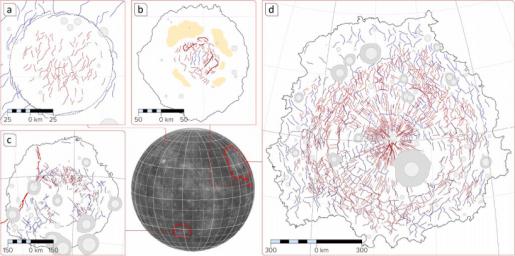
|
Tectonic Complexity in Mercury’s Impact Features
- Click the image above for a larger view
- Full-Res JPEG (1024 x 509) (136.3 kB)
- Full-Res TIFF (1024 x 509) (1.6 MB)
Caption:
Mercury's surface is covered with impact craters , many of which have been flooded by lavas . A subset of flooded impact features host tectonic structures -- graben (shown in red in the figure above) and ridges and scarps (blue) -- that formed during or after volcanic infilling. Such impact features range from so-called "ghost craters" through medium-sized basins such as Mozart , to the largest basins on Mercury, including Rembrandt and the mighty Caloris . Mapping these structures, and so characterizing their nature and spatial and temporal distributions, helps scientists understand the processes responsible for the tectonic complexity within volcanically infilled craters and basins on Mercury.
Date released:
February 1, 2013
Center Latitude:
(a) 60.3°, (b) 7.8°, (c) -33.5°, (d) 30°
Center Longitude:
(a) 36.7° E, (b) 169.6° E, (c) 88°E, (d) 161°E
Projection:
Orthographic
Background Info:
The MESSENGER spacecraft is the first ever to orbit the planet Mercury, and the spacecraft's seven scientific instruments and radio science investigation are unraveling the history and evolution of the Solar System's innermost planet. MESSENGER acquired over 150,000 images and extensive other data sets. MESSENGER is capable of continuing orbital operations until early 2015.
For information regarding the use of images, see the MESSENGER image use policy .
Cataloging Keywords:
| Name | Value | Additional Values |
|---|---|---|
| Target | Mercury | |
| System | ||
| Target Type | Planet | |
| Mission | MESSENGER | |
| Instrument Host | MESSENGER | |
| Host Type | Orbiter | |
| Instrument | ||
| Detector | ||
| Extra Keywords | Color, Crater, Impact, Radio, Volcano | |
| Acquisition Date | ||
| Release Date | 2013-03-20 | |
| Date in Caption | 2013-02-01 | |
| Image Credit | NASA/Johns Hopkins University Applied Physics Laboratory/Carnegie Institution of Washington | |
| Source | photojournal.jpl.nasa.gov/catalog/PIA16900 | |
| Identifier | PIA16900 | |
